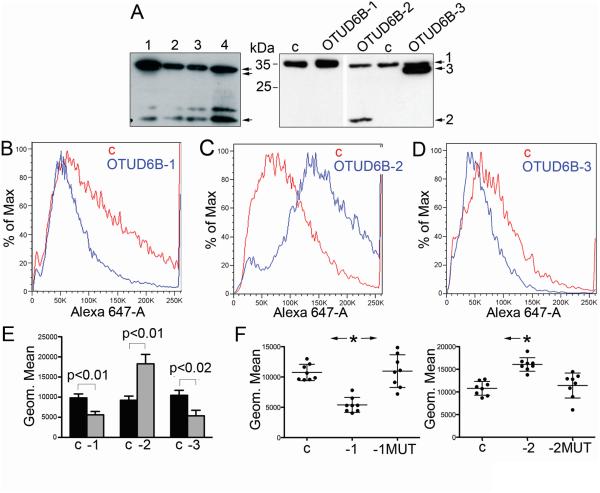Figure 4.
The two main OTUD6B splice variants have opposite effects on global protein synthesis; their activity appears to require the catalytic cysteine. A, Western blot analysis of the OTUD6B isoforms. Left; immunoblots in four NSCLC cell lines (1, A549; 2, H1755; 3, H1437; 4, H1650). For OTUD6B isoforms detection, please see Materials and Methods. Right; representative immunoblots of H1299 cells 48 hours after transient transfection with the specified OTUD6B isoforms cloned in pcDNA3-. Arrowheads indicate the three OTUD6B isoforms. B, C, D, representative AHA incorporations in H1299 after transfection with the indicated plasmids; c, control. E, summary of AHA incorporation in cell lines A549, H1299 and H1437 (two experiments in each cell line) after transfection with the indicated plasmids; c, pCDNA3-; -1, OTUD6B-1; -2, OTUD6B-2; -3, OTUD6B-3. P values refer to t-test performed on all data considered as independent values. F, summary of eight independent AHA experiments performed in H1299 cells after transfection with the indicated OTUD6B isoforms and their mutants at the catalytic cysteine. C, control; -1, OTUD6B-1; -1MUT, OTUD6B-1 C188S; -2, OTUD6B-2; -2MUT, OTUD6B-2 C57S. Statistics: one-way ANOVA; asterisk on left histogram, OTUD6B-1 is statistically significant in Friedman/Dunn's tests to both control (p=0.008) and OTUD6B-1 C188S. Control and OTUD6B-1 C188S are not significantly different. Asterisk on right histogram, OTUD6B-2 is statistically significant in Friedman/Dunn's tests compared to control (p=0.018).

